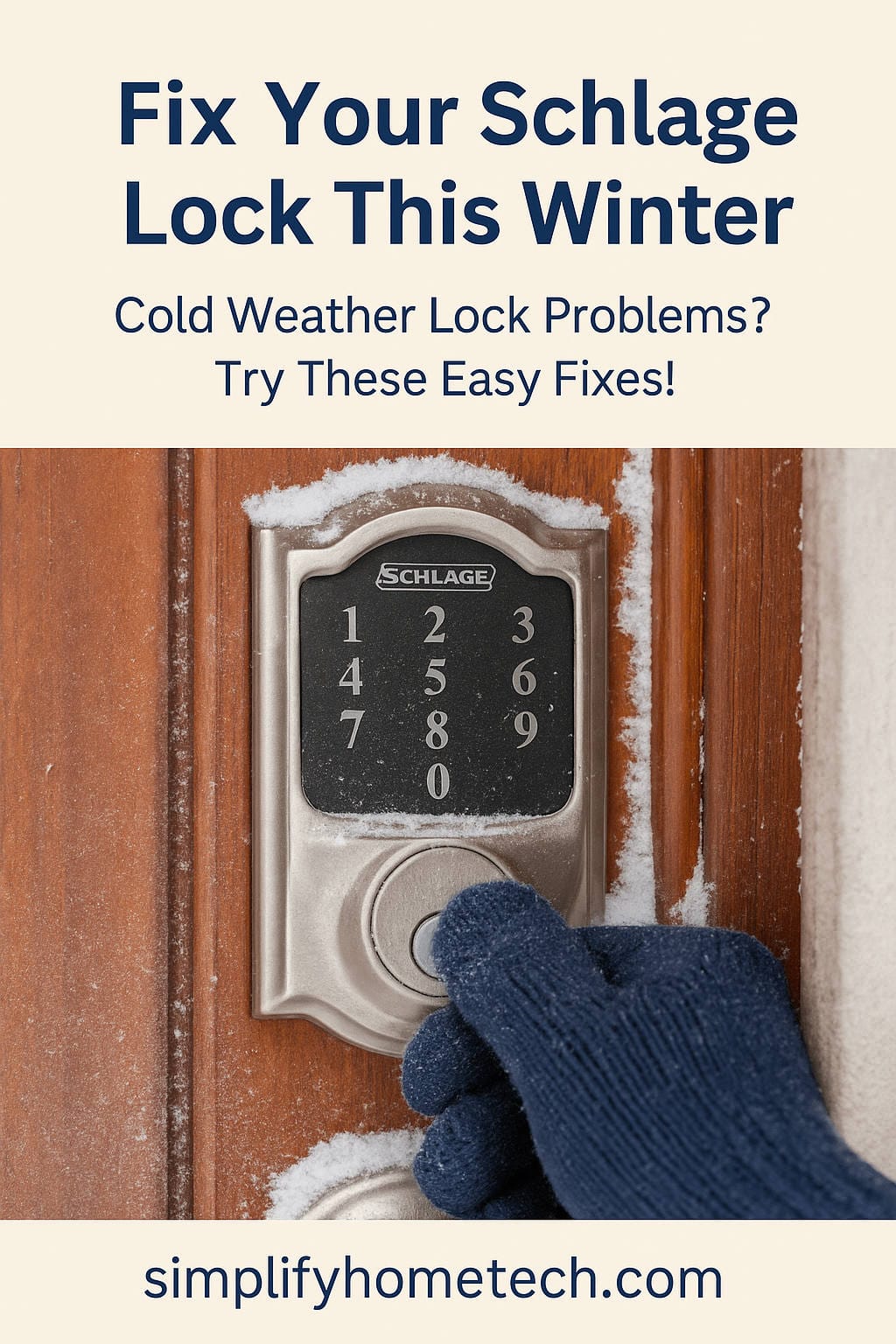Schlage keypad locks are known for their reliability, ease of use, and robust security features. Whether you’re using a model like the Schlage Encode, Schlage Connect, or the traditional Schlage BE365, these locks offer a dependable alternative to traditional keyed locks. However, when temperatures plummet in winter, even the most advanced electronic locks can run into problems. If you’ve ever found yourself locked out on a frosty morning, frantically jabbing your code into an unresponsive keypad, you’re not alone.
Cold weather can wreak havoc on the functionality of your Schlage lock. Many users report that the keypad becomes sluggish, the deadbolt fails to engage, or the battery drains much faster than usual. This article will walk you through why Schlage locks struggle in the cold and how you can fix—and even prevent—these winter issues.
Let’s dive into everything you need to know to keep your Schlage keypad working reliably, no matter how harsh the weather gets.
How Cold Weather Affects Schlage Keypad Locks
To understand the issues, we need to look at how cold temperatures impact the components inside a Schlage keypad lock. There are several ways that winter weather can interfere with its performance:
Battery Efficiency Drops Significantly
Schlage locks typically run on AA alkaline batteries. While these are adequate in most conditions, they are not ideal for cold environments. Alkaline batteries contain a water-based electrolyte that becomes sluggish when temperatures drop. As the chemical reaction slows, the battery can’t provide enough voltage to power the lock.
This is why you may find your keypad completely dead, the screen refusing to light up, or the motor stalling when you attempt to unlock the door.
Moisture Can Freeze Inside the Lock
Condensation is a major culprit in winter lock malfunctions. Warm indoor air can seep into the lock’s components, and when it meets the frigid outer shell of the lock, condensation forms. If the temperature continues to drop, this moisture freezes. Frozen condensation can jam mechanical parts or damage internal electronics.
Over time, this can lead to corrosion on battery terminals or the circuit board, resulting in erratic performance or total failure.
Metal Contracts and Lubricants Harden
The metal parts inside your lock—springs, gears, deadbolts—all respond to cold temperatures by contracting. This can lead to alignment issues or additional friction, making it harder for the lock to engage or disengage.
Additionally, if the lock is lubricated with an oil-based or silicone lubricant, that lubricant may thicken or solidify in cold weather. This increases resistance inside the lock and can make the motor overwork or stall completely.
Door and Frame Shifting
Extreme cold can also affect the door itself. Wood swells or shrinks with temperature and humidity changes, and this can affect how the bolt aligns with the strike plate. If the bolt doesn’t line up perfectly, the lock mechanism may jam or make unusual noises when trying to turn.
All these issues are magnified in very cold climates or during storms where the wind chill and moisture level is high.
Common Cold Weather Problems with Schlage Keypad Locks
Understanding how these components react to cold weather helps explain the variety of symptoms users experience. Here are the most frequent problems Schlage lock owners report during winter months:
- Keypad won’t light up – Usually caused by cold-depleted batteries.
- Code accepted but lock won’t open – Possibly due to frozen internal parts or bolt misalignment.
- Lag or delay after entering code – Often related to cold-affected battery performance.
- Thumbturn or knob hard to rotate – A mechanical issue due to frozen lubricant or contracting metal.
- Red blinking or beeping after entry – Low battery warning, more common in freezing temperatures.
- Lock randomly resets or behaves erratically – Often tied to internal condensation or corrosion.
- Lock works during the day but fails at night – Indicative of temperature drops overnight affecting performance.
While these issues may seem frustrating, they are typically easy to fix with a few preventive measures and minor adjustments.
How to Fix a Schlage Lock That’s Not Working in the Cold
If your Schlage lock has already started to struggle in cold weather, there are several steps you can take to bring it back to working condition.
1. Replace Batteries with Lithium AAs
This is by far the most effective fix for cold-related lock issues. Lithium AA batteries are designed to perform in extreme temperatures, often rated for use down to -40°F (-40°C). They provide a more stable voltage output and don’t suffer from the same performance dips as alkaline batteries.
How to do it:
- Remove the cover from the inside unit of the lock.
- Take out the old alkaline batteries.
- Insert a fresh set of Energizer Ultimate Lithium AA batteries.
- Power on the lock and test its function.
This one step often resolves most cold-weather malfunctions, especially if the keypad had gone dark or the motor was unresponsive.
Important: Always replace all batteries at the same time, and never mix lithium with alkaline batteries.
2. Warm the Lock Temporarily
If you find yourself locked out in freezing temperatures, warming the lock may help temporarily. You can use:
- A hand warmer
- A warm compress
- A hairdryer (use with caution to avoid moisture damage)
- Even just your bare hands cupped over the lock
Once warmed, the frozen condensation or stiff internal components may loosen enough for you to open the door.
3. Clean and Inspect Battery Contacts
Battery terminals inside the lock may accumulate corrosion or moisture residue, especially after a few winters. If power seems intermittent, it’s worth opening the lock and inspecting the terminals.
Steps:
- Remove batteries.
- Use a Q-tip with a bit of isopropyl alcohol or white vinegar.
- Gently scrub any rust or buildup.
- Dry thoroughly before reinserting new batteries.
A light sanding may be required if there’s significant corrosion. Clean contacts improve conductivity and reduce power loss in cold conditions.
4. Use the Right Lubricant
Standard lubricants like WD-40 or silicone sprays can thicken in low temperatures. Instead, use a dry lubricant that won’t attract dirt or freeze.
Recommended options:
- Graphite powder
- Dry Teflon lubricant (e.g., DuPont Teflon Dry Lube)
Apply a small amount inside the keyhole (if your model has one), on the deadbolt, and on moving parts like the thumbturn. Be cautious not to over-lubricate.
5. Fix Strike Plate Alignment
If your lock’s deadbolt isn’t retracting or extending properly, the issue may lie with the door rather than the lock itself. As doors expand and contract in cold weather, the strike plate may no longer align with the bolt.
To fix this:
- Tighten any loose hinge screws.
- Adjust the strike plate by loosening its screws and moving it slightly.
- If necessary, file the strike plate opening to widen it.
- Install weather stripping to improve door alignment and insulation.
This simple adjustment can reduce motor strain and prevent jamming.
6. Reset the Lock
Sometimes, a soft or factory reset can help resolve odd behaviors caused by temporary battery failure or internal glitches due to condensation.
Soft reset:
- Remove batteries, wait 30 seconds, and reinstall them.
Factory reset (Schlage BE365 and similar models):
- Remove the battery pack.
- Press and hold the “Schlage” button.
- While holding it, reconnect the battery.
- Release the button when you see a green light and hear a beep.
Note: A factory reset will erase all user codes and settings, so only use it if necessary.
7. Add External Protection
Adding physical protection to the lock can reduce its exposure to wind, snow, and rain.
- Install a lock weather shield or silicone cover designed for Schlage keypads.
- Mount a small awning or visor above the door to shield the lock.
- Use an insulated cover at night or during snowstorms to prevent freezing.
Preventing exposure to the elements is just as important as internal maintenance.
Proactive Maintenance Tips for Winterizing Your Schlage Lock
Prevention is the key to avoiding cold-weather problems altogether. A few minutes of preparation in the fall can save you hours of frustration during a snowstorm.
Here are the best ways to keep your Schlage lock functioning smoothly all winter:
Switch to Lithium Batteries Before Winter
Don’t wait for the first freeze. As soon as fall arrives, swap out alkaline batteries for lithium ones. Not only will they perform better, but they’ll also last longer—often up to a year or more in moderate use.
Lubricate in Fall and Mid-Winter
Apply a light coating of dry graphite or Teflon lubricant to all mechanical parts before winter starts and again mid-season if needed. This prevents freezing and keeps the mechanism moving freely.
Inspect and Clean the Lock Monthly
Once a month, wipe down the lock with a dry cloth to remove dirt, moisture, or ice buildup. Check the battery level if your model displays a low battery indicator.
Weatherproof the Door
Seal gaps around your door frame to reduce wind chill and moisture infiltration. Use foam weather stripping or rubber door sweeps. This helps maintain a more consistent temperature around the lock.
Keep Backup Entry Options Ready
Always carry your backup key or have it stored in a secure location (such as a lockbox) in case your keypad fails. If your model supports remote access via Wi-Fi or Bluetooth, test it regularly during the winter.
When to Consider Replacing Your Schlage Lock
If your lock continues to malfunction despite maintenance, it may be time for a replacement—especially if it’s over five years old or showing signs of rust or internal water damage.
Signs It’s Time to Replace the Lock:
- Keypad unresponsive even after new batteries
- Persistent condensation or corrosion issues
- Deadbolt won’t move despite correct code
- Internal motor noises without movement
- Random resets or data loss
Consider upgrading to a newer model like:
- Schlage Encode Plus – Wi-Fi enabled, cold-resistant, supports Apple HomeKey
- Schlage Connect – Works with Z-Wave smart home systems
- Schlage BE499 – Improved cold-weather battery efficiency and stronger internal seals
Newer models are better insulated, offer stronger electronics, and respond more efficiently to commands.
Frequently Asked Questions
Why does my Schlage lock beep and blink red when it’s cold?
This typically indicates a low battery. Cold temperatures can significantly reduce battery output. Replacing the batteries with lithium versions usually solves the issue.
Can I use rechargeable AA batteries in my Schlage lock?
It’s not recommended. Rechargeable AA batteries typically output only 1.2V, while Schlage locks require 1.5V for optimal performance.
What temperature range can Schlage locks operate in?
Most Schlage electronic locks are rated to operate down to -31°F (-35°C). However, battery performance may degrade before this limit, especially with alkaline batteries.
Is it safe to use a hairdryer to thaw a frozen lock?
Yes, but with caution. Use a low setting, and do not let moisture get into the lock’s electronics. Avoid prolonged heat exposure.
Does Schlage make a cold-weather-specific lock?
While Schlage locks are rated for outdoor use, none are made specifically for Arctic climates. The best solution is to use lithium batteries, proper lubrication, and external weather protection.
Final Thoughts
Winter can be tough, but your Schlage keypad lock doesn’t have to suffer through it. With proper maintenance, the right batteries, and a few adjustments, your lock can operate just as reliably in the dead of winter as it does in summer.
From understanding how cold affects batteries and moving parts to applying the right lubricants and installing weather shields, each step outlined in this guide helps ensure your Schlage lock performs at its peak—even during snowstorms and sub-zero temperatures.
If you follow these tips and tricks, you’ll not only prevent lockouts and frustration but also extend the life and reliability of your lock for many winters to come.
You might also like,

